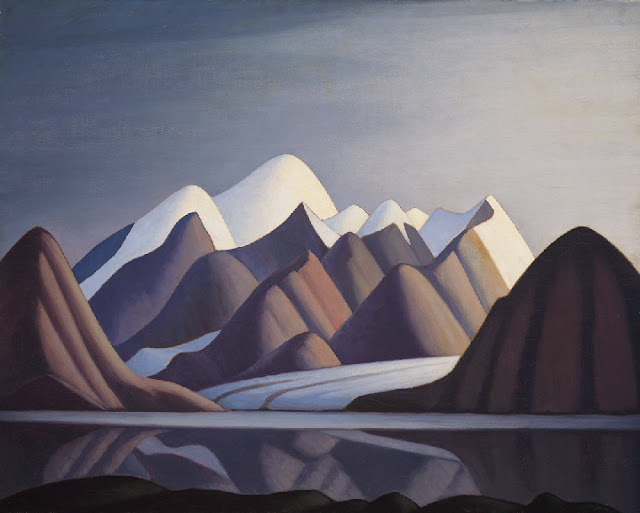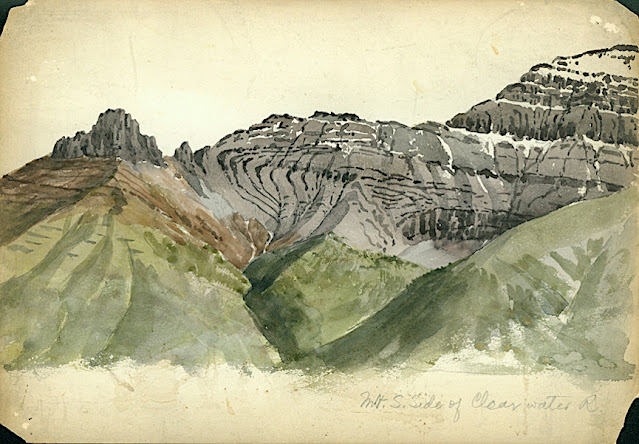LAWREN S. HARRIS (1885–1970)
Isolation peak (3,983 m - 13,067 ft)
1. painted in 1930
2. painted between 1925
3. painted between 1925 and 1930
The painter
Lawren Stewart Harris, (1885–1970) was a leading landscape canadian painter, imbuing his paintings with a spiritual dimension. An inspirer of other artists, he was a key figure in the Group of Seven and gave new vision to representations of the northern Canadian landscape. During the 1920s, Harris's works became more abstract and simplified, especially his stark landscapes of the Canadian north and Arctic. He also stopped signing and dating his works so that people would judge his works on their own merit and not by the artist or when they were painted.
In 1924, a sketching trip with A.Y. Jackson to Jasper National Park in the Canadian Rockies marked the beginning of Harris' mountain subjects, which he continued to explore with annual sketching trips until 1929, exploring areas around Banff National Park, Yoho National Park and Mount Robson Provincial Park. In 1930, Harris went on his last extended sketching trip, travelling to the Arctic aboard the supply ship
SS. Beothic for two months, during which time he completed over 50 sketches.
"We are on the fringe of the great North and its living whiteness, its loneliness and replenishment, its resignations and release, tis call and answer, its cleansing rhythms. It seems that the top of the continent is a source of spiritual flow that will ever shed clarity into the growing race of America."
(Lawren S. Harris, 1926)
For Harris, art was to express spiritual values as well as to represent the visible world. North Shore, Lake Superior (1926), an image of a solitary weathered tree stump surrounded by an expanse of dramatically lit sky, effectively evokes the tension between the terrestrial and spiritual.
The resulting Arctic canvases that he developed from the oil panels marked the end of his landscape period, and from 1935 on, Harris enthusiastically embraced abstract painting. Several members of the Group of Seven later became members of the Canadian Group of Painters including Harris, A. J. Casson, Arthur Lismer, A. Y. Jackson, and Franklin Carmichael.
From 1934 to 1937, Harris lived in Hanover, New Hampshire, where he painted his first abstract works, a direction he would continue for the rest of his life. In 1938 he moved to Sante Fe, New Mexico, and helped found the Transcendental Painting Group, an organization of artists who advocated a spiritual form of abstraction.
In 1969, he was made a Companion of the Order of Canada.
Harris died in Vancouver in 1970, at the age of 84, as a well-known artist. He was buried on the grounds of the McMichael Canadian Art Collection, where his work is now held.
On November 26, 2015 his painting Mountain and Glacier was auctioned for $3.9 million at a Heffel Fine Art Auction House auction in Toronto, breaking the previous record for the sale of one of Harris's works.
In 2016 a film about Harris's life, Where the Universe Sings, was produced by TV Ontario. It was created by filmmaker Peter Raymont and directed by Nancy Lang.
Reference
-
Lawren S. Harris biography in National Gallery of Canada notice
The mountain
Residing far away from just about everywhere, the well-named Isolation Peak (3,983 m - 13,067 ft) occupies some prime terrain at the southern end of the great Rocky Mountain National Park, near Georgetown, Colorado, United States. Based on peakery data, it ranks as the 606th highest mountain in Colorado and the 848th highest mountain in the United States.
For now at least, Isolation's vast summit view will stay her own, reserved for enduring souls that love solitude and long for even the obscure summits of Rocky Mountain National Park. So, if you like sacred places, then see for yourself the unique views Longs Peak, Mount Alice, Paradise Park and the pristine Fifth Lake area of East Inlet Basin. Most of all, go get Isolated!
The officially named Isolation Peak resides directly on the Continental Divide, a few miles south of Mount Alice and a few miles north of Ogalalla Peak. Its rocky summit towers over four different drainages, two west facing watersheds, (East Inlet & Paradise Park) and another two that face east (Thunder Lake & Frigid Lake.)
The west side of Isolation Peak harbors some of Colorado's most pristine land. Paradise Park is a designated Research Natural Area that is used for scientific investigations which requires the area to be unaltered by human intervention. Day hiking is allowed, but there are no maintained trails and camping is not allowed. The reclusive Fifth Lake area is another distant place protected by another long 8-mile approach.
From the Divide, the eastern aspects of Isolation Peak are named Wild Basin. Logistically, one can argue that Wild Basin is no more spectacular than the western aspects of East Inlet or Paradise Park. However, Wild Basin's proximity to Denver makes for a familiar, and well-named place. Protected by National Park status, the vast Wild Basin is known for its long approaches and extensive trail system. Many beautiful alpine lakes reside here, protected by miles of tree-laden landscape. Even further away and beyond those lakes resides obscure mountainous terrain. Peaks like Copeland Mountain, Ouzel Peak, Mount Alice, Tanima Peak and Chiefs Head, make up a natural boundary for Wild Basin. Wild Basin is within RMNP boundaries, if interested, you will need a camping permit to split your 17-mile adventure into two days. Attaining Wild Basin camping permits is not as difficult as you may think; just stay away from weekend crowds.
The nearest peaks are Mahana Peak, Eagles Beak, The Cleaver, Ouzel Peak, Tanima Peak, and Copeland Mountain. Isolation Peak belongs to the Rocky Mountain National Park Peak Challenge peak list. See the Isolation Peak map, 3D fly around, and the Isolation Peak photos to get a better sense of the mountain.
Climbing
Isolation Peak is aptly named: far from any trailheads, it seems to be seldom climbed. The approach from the eastern side is from Wild Basin, about 13 miles south of Estes Park.
Camp below Bluebird Lake, about 5.5 miles from the trailhead, to get an early start. Try to get a permit for the Upper Ouzel Creek campsite, which is said to be the prettiest in the area. Located above the trail in a stone perch, with the steep slopes of Copeland Mountain and a small waterfall across the valley, it is indeed a lovely site. The Indian Paintbrush and Columbine flowers are spectacular.
From Bluebird Lake, the route ascends a slope to the north, over fairly steep and often loose talus, to a relatively flat bench. Cairns mark a reasonably good route to the top. The best way to avoid the bushes is to head to the west, directly down toward the creek flowing from Pipit Lake toward Bluebird Lake. Two small clearings are linked and lead to the creek area, which is free of the dense bushes; then follow the creek up toward Pipit Lake. Due to the global change of climate, many mountains are now free of snow, the cirque between Ouzel Peak and Isolation Peak (one route to the top) still has quite a bit of snow.
There is an other way, via Isolation Lake.
From the Pipit Lake area, head up to the right. From here there is an obvious route up to the saddle between Isolation Peak, and Mahana Peak, then up the ridge to the summit. On can go up directly toward the summit, over fairly steep but mostly stable talus.
There is a PVC pipe for the summit register, but no register, just a Ziploc freezer bag containing several slips of paper.
It appears that this peak is not climbed often (perhaps a dozen times per year). There are some dramatic views to Isolation Lake, to the south ridge of Isolation Peak, and especially to the west down to Fifth Lake, which has some angular rock formations. There is a steep drop-off on the west side of Isolation Peak.
References
-
Isolation peak notice in Summit.org
-
Isolation peak notice in Peakery
-
Gordon S. Novak Jr. climbing route





















